Owls are some of the most mysterious creatures in the world. Many of them are nocturnal and part of different mysteries.
While colorful, their eyes can also be orange or red.
Unlike other birds, the eyes of owls are large in proportion to their disc-shaped heads. This is why red eyes are some of the nuances that stand out the most.
In popular culture, red-eyed owls have even been named Devil Owls, mainly for reflecting red light under flashlights and lampposts at night.
The following species have either orange or red eyes during the day or at night when light reflects differently on their eyes.
Table of Contents
1. Stygian Owl
Nothing about the Stygian Owl (Asio stygius) would see the species as something to be feared during the day.
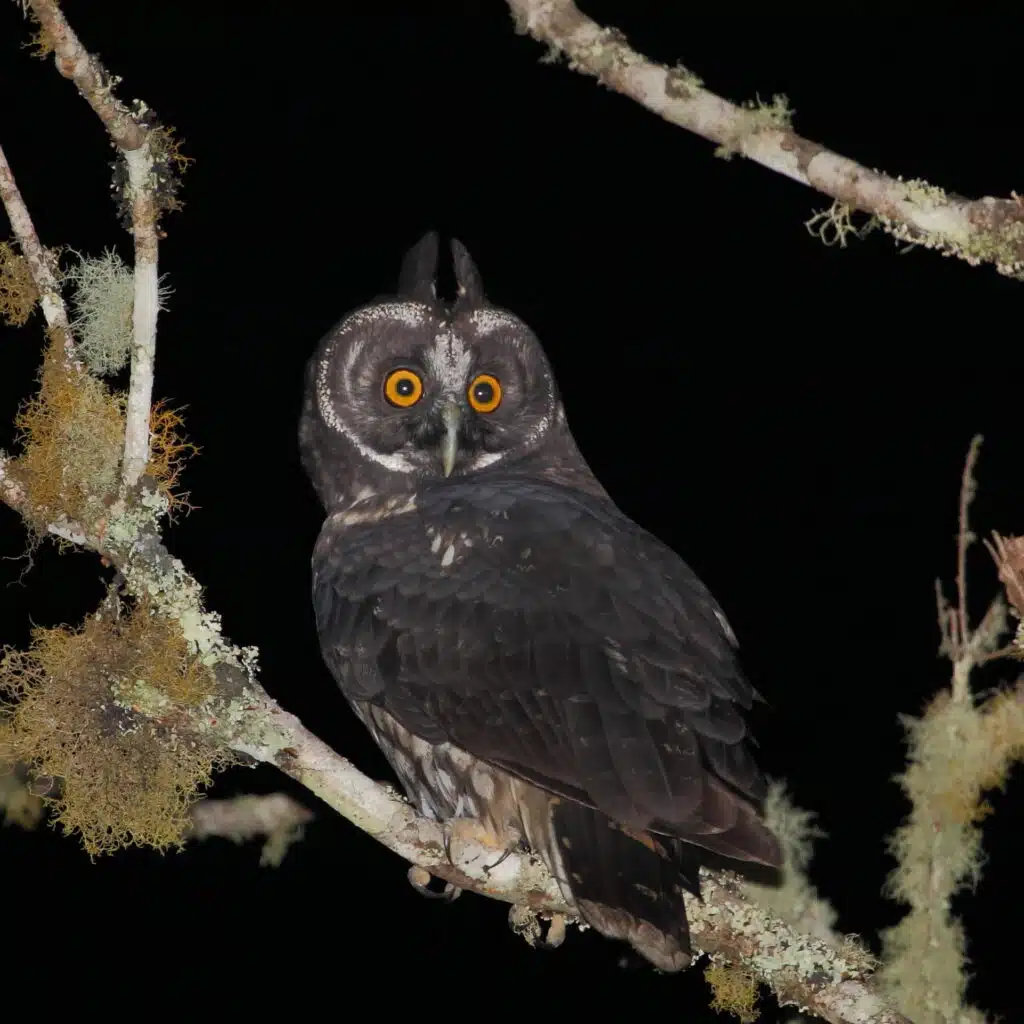
At night, its eyes reflect a red color under artificial light. This has also prompted its nickname of The Devil Owl.
A species of Brazil, Paraguay, and Central American forests, this species has yellow eyes but they reflect red nuances at night.
One reason why this owl is only associated with red and not yellow eyes is its nocturnal feeding habit.
As it rests during the day, people only spot it at night, when its eyes get a red reflection.
Stygian Owls are avid predators and among the owls, they may feed on larger birds such as Lesser nothuras.
A brown and white type of owl, the species may also be spotted as it perches during the day.
Its 6 subspecies are found in forests as South as Southern Brazil and further North as The Sonoran Desert.
They all appear to have bright or dark yellow eyes during the day.
This species can also be heard with its specific owl-like deep and slow vocalization.
The red nuance of the eyes – vivid red
2. Long-Eared Owl
Long-eared Owls (Asio otus) have an even wider distribution, being found across The Northern Hemisphere.
Its subspecies come in different eye nuances such as orange and red.
The Long-Eared Owl living in The Canary Islands has the closest eye color to red nuances, even other subspecies can also have orange-red nuances.
Yellow-orange and orange-red eyes are the most common on The Long-Eared Owl.
An orange-red nuance is also specific to the reflections of its eyes during the night.
Apart from its bright eyes, this owl also stands out with its elongated upward ear tufts.
This species is found in deep and dense woodlands and may never be seen.
Preferring thick vegetation to live in, this type of owl is also adaptable when it comes to prey so that it doesn’t have to leave its area for food.
Some subspecies of the owl may still migrate, particularly those living in cooler climates.
Migrations routes are often long. For example, long-eared owls can migrate as far as Central Asia to East Africa.
The red nuance of the eyes – orange-red, bright red
3. Eurasian Eagle-Owl
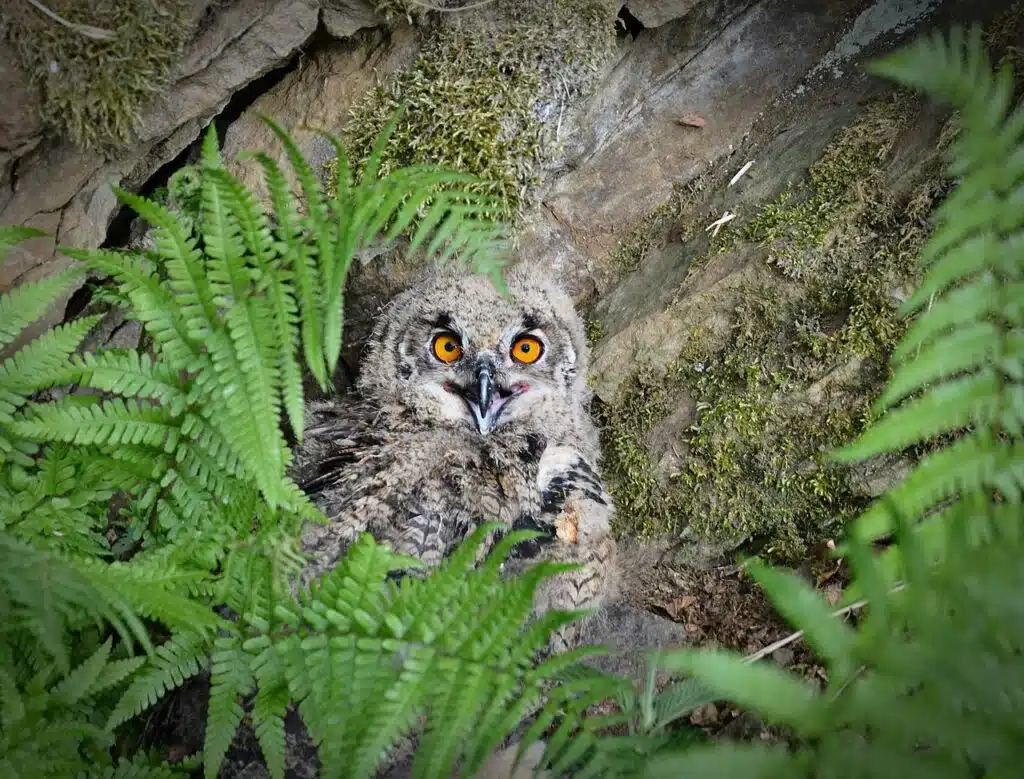
Large orange-red eyes are specific to the widespread Eurasian Eagle-Owl (Bubo bubo). This is a species that lives in forests but also parks and gardens.
As one of the owls with red eyes that are easy to spot, Eurasian Eagle-Owls are found next to woodlands and in savannahs as well.
They prefer to live at the edges of woodlands where they can spot rodents to feed on.
In some cases, their diet may also be more diverse. This is mostly specific to larger Eurasian Eagle-Owls.
Both dark and mostly brown as well as bright mostly whit Eurasian Eagle-Owls are found in Europe and Asia.
They can be large as an expected maximum wingspan of over 20 inches is specific to the species.
An owl that molts frequently, the Eurasian Eagle-Owl is one of the species that has red eyes throughout all of its morphs.
A species that may be similar to Snowy Owls when white or to other owls in its dark morph, The Eurasian Eagle-Owl is mostly specific to mountainous regions.
An undisturbed habitat and plenty of food may even allow this species to live up to 20 years.
The red nuance of the eyes – orange-red
4. Northern White-Faced Owl
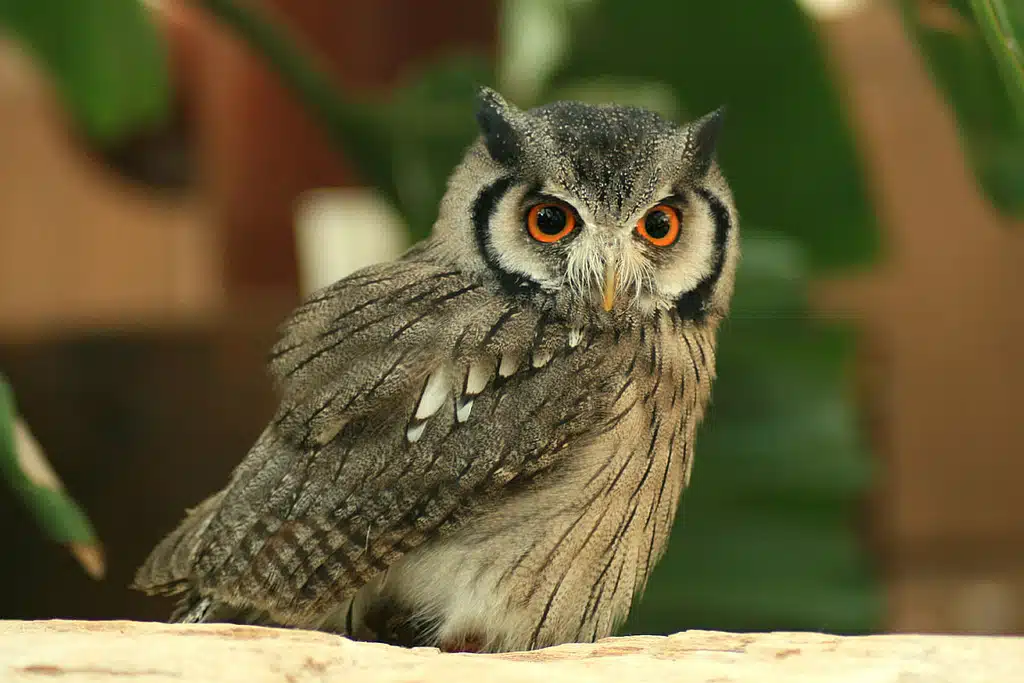
A species of sub-Saharan African, Northern White-Faced Owls (Ptilopsis leucotis) are bright, almost white. They also show mostly red eyes with a bright nuance or an orange-red nuance.
From Western to Eastern Africa, this is a species that lives in the forests of Guinea, Sierra Leone, Eritrea, Djibouti, and other countries.
This species possesses multiple defensive tactics, including the capacity to look bigger or smaller.
Northern White-Faced Owls can look smaller by pulling their feathers towards the body. The main idea is to look similar to a branch or to reduce their body size so that eagles and other predators don’t see them.
These owls can also become larger, opening up their wings to appear as large as possible.
While their red and orange eyes might be scary to predators, these owls close them almost completely so that they don’t draw in extra unwanted attention.
The red nuance of the eyes – bright red
5. Japanese Scops-Owl
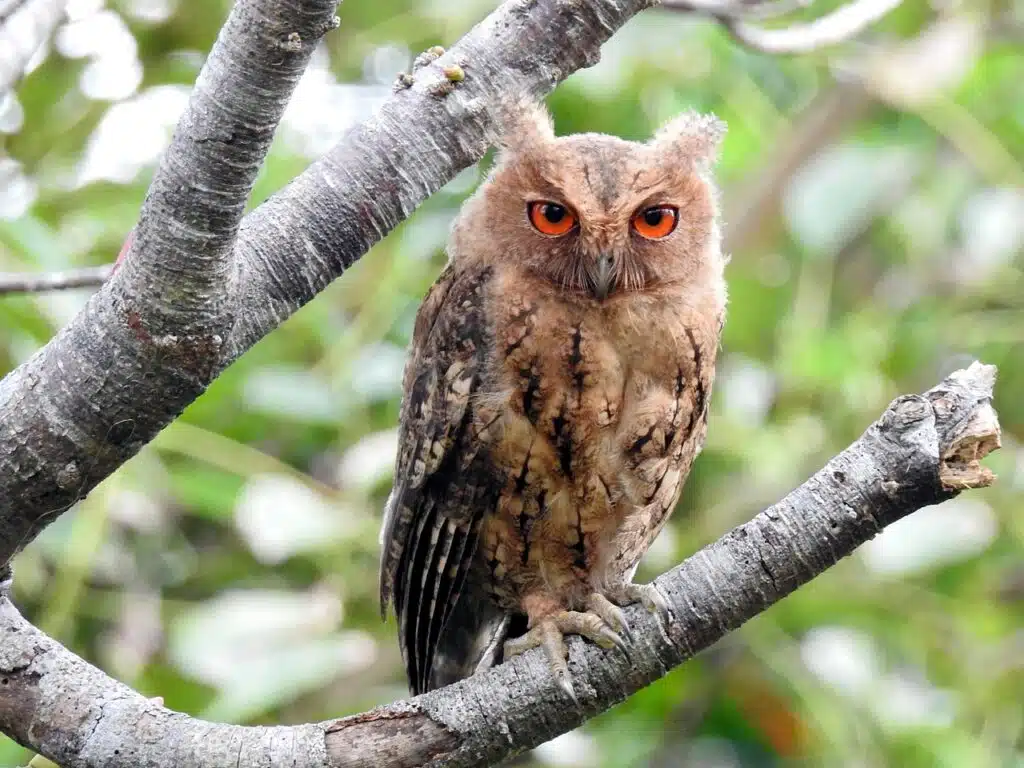
This species (Otus semitorques) is native to Japan, North Korea, South Korea, and Eastern China.
It features large orange-red eyes with a bright tan-brown facial disc. Its wings are dark brown and black.
While its eyes almost appear red during the day, they appear fully red at night.
The reflection of their irises may seem red but even the pupils turn red at night when flashed.
As a result, Japanese Scoops-Owls have bright red eyes at night, under artificial light such as a flashlight or a lamppost.
While its plumage can vary to darker brown nuances, its red eyes remain bright red when flashed at night.
Other atypical characteristics of Japanese Scoops-Owls include having multiple vocalizations.
This species has that deep woot call of owls but it can also vocalize like cats, dogs, and frogs.
The red nuance of the eyes – orange-red, dark red
6. Rock Eagle-Owl
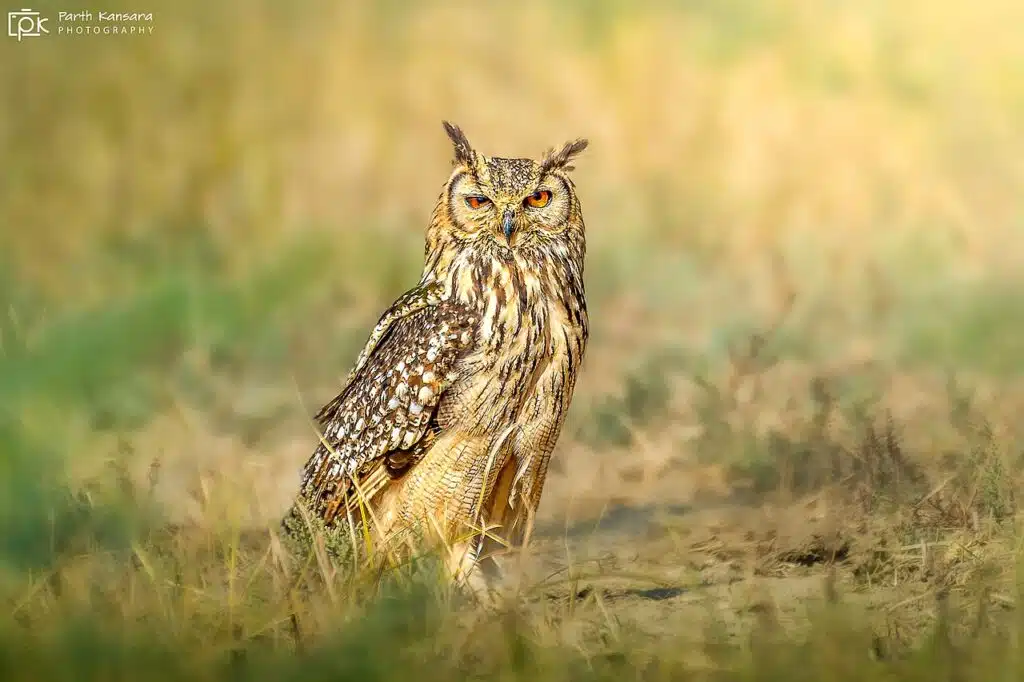
A species of The Indian Subcontinent, Rock Eagle-Owls (Bubo bengalensis) are among the owls with red eyes in Asia.
Orange-red nuances are specific to their eyes with vivid red nuances at night, under artificial light.
Brighter than other types of owls, Rock Eagle-Owls have an almost completely white appearance at first, as juveniles.
This is a species with short black tufts, a white face disc, and almost fully red eyes as adults.
A successful predator, the owl eats rodents and birds. Some of the most atypical prey for this owl also includes young peafowls.
All of these types of prey are particularly common to the hills and the higher elevation grounds they live in.
The red nuance of the eyes – orange-red
7. Southern White-Faced Owl
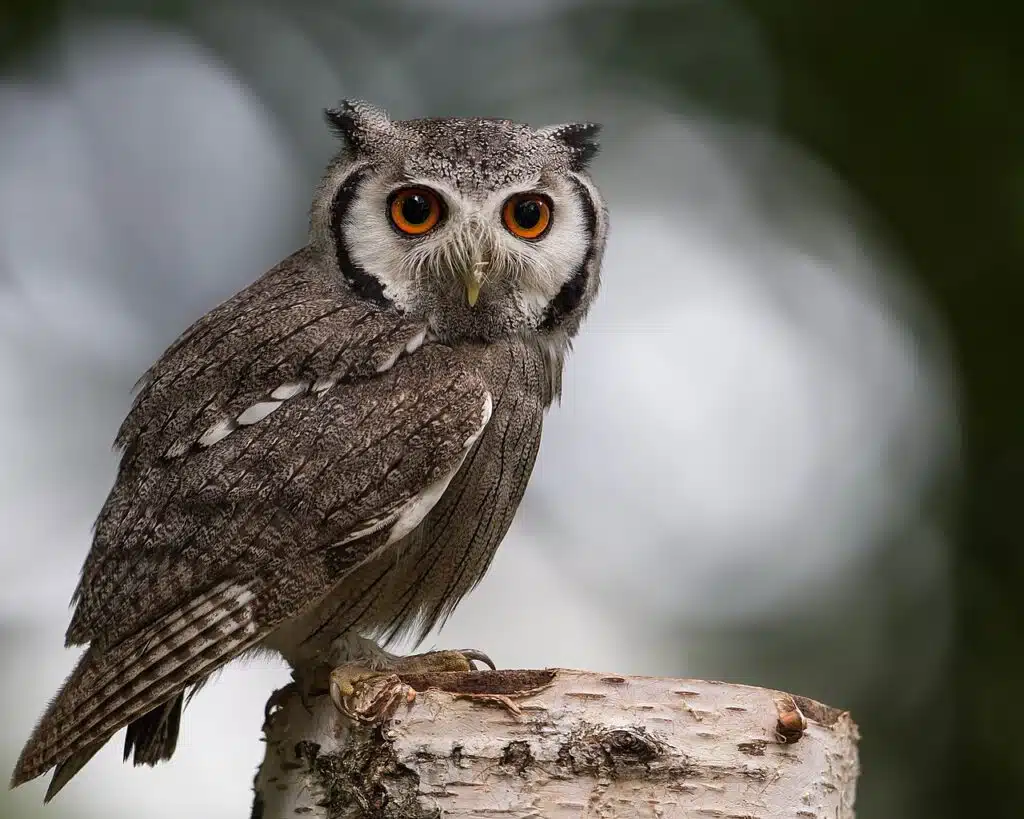
Orange-red and red eyes are also species on The Southern White-Faced Owl (Ptilopsis granti).
This species is native to some of the most remote regions of Africa in a cross-state presence. It lives in Southern states such as Angola, Zambia, Botswana, and Namibia.
Known for its bright rather gray-white plumage, this is a species that may be seen in the savannah, dry areas, shrubland, or the edges of various forests.
Southern White-Faced Owls are further identified by the black margins of their silver-white face discs.
A species with vivid eye coloring, Southern White-Faced Owls are mostly spotted or heard during the breeding season.
It lives solitary lives outside of the breeding season, hiding in holes during the day.
These types of owls may be heard vocalizing before and during the breeding season. Both males and females have specific vocalizations.
Known for the almost trill-like repetitive sharp vocalizations, the female owl lays at least 2 eggs after breeding.
Females of the species don’t build their nests but prefer to lay these eggs in the nests made by other birds or abandoned nests.
The red nuance of the eyes – orange-red
8. Javan Scops-Owl
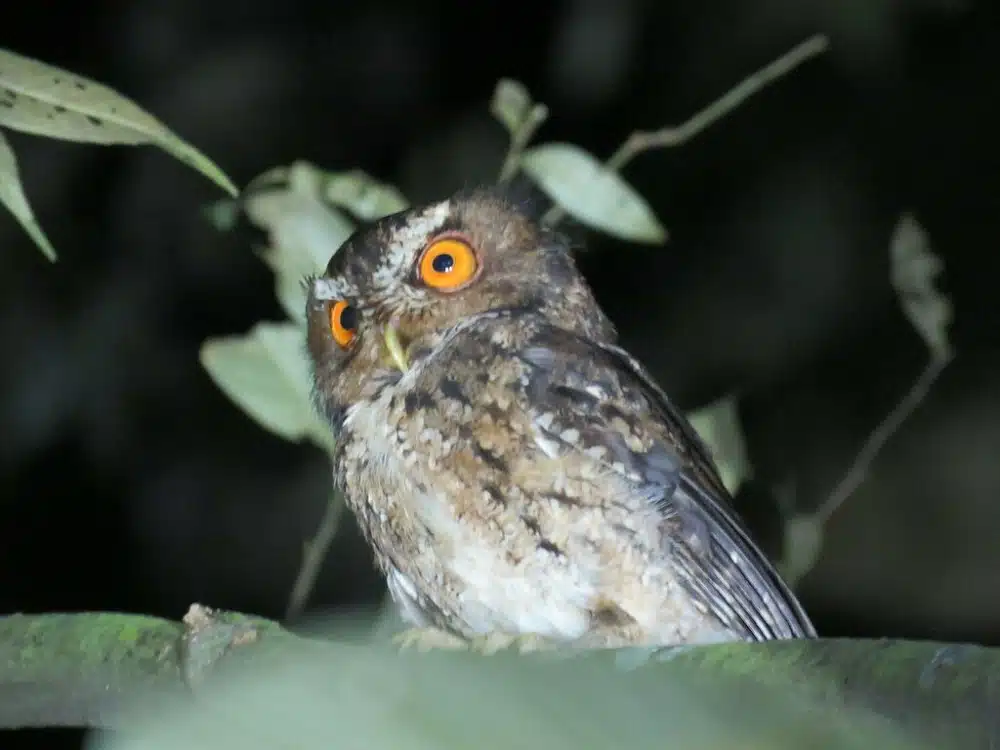
Native to Indonesia, these types of red-eyed owls (Otus angelinae) are only present in the West Javas.
This is a Western territory of forests where the owls live at an elevation of a few thousand feet.
Their eyes come in different nuances but are mostly orange-red.
A species of the lower canopy and lower elevations, Javan Scops-Owls live in forests across national parks.
These types of owls are rarely heard due to their remote living and due to their almost muted calls compared to other types of owls.
The diet of these small owls is also distinct from other species.
Mostly an insectivore, The Javan Scops-Owl is a species that feeds on bugs such as grasshoppers and praying mantises.
The red nuance of the eyes – orange-red, red-brown
9. Negros Scops-Owl
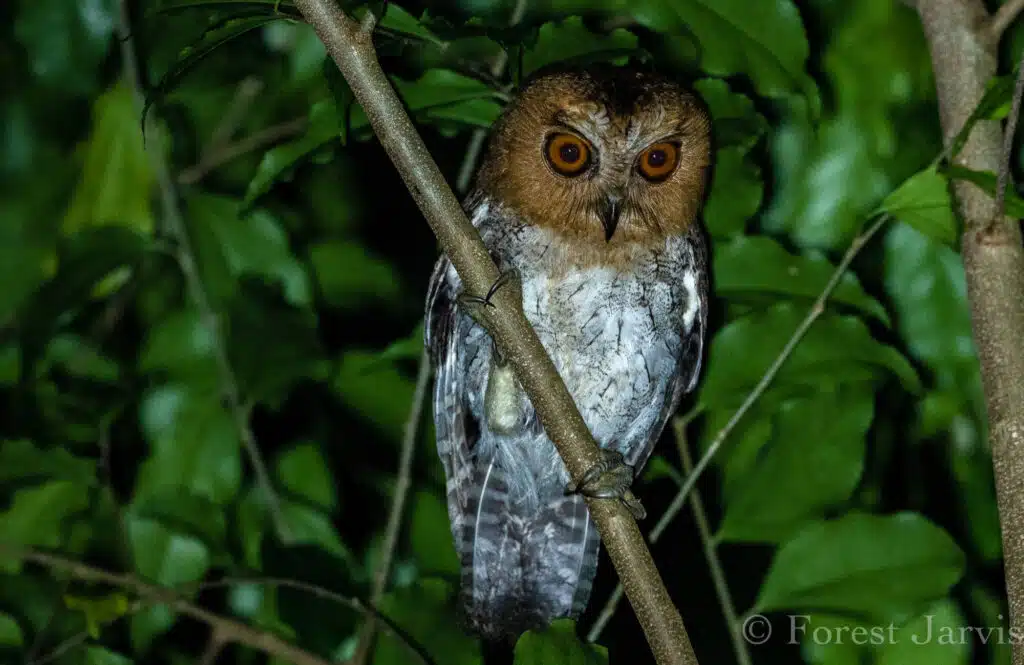
A species native to The Philippines, Negros Scops-Owls (Otus nigrorum) are among the species with red eyes.
The eyes of these owls may have different colors. They range from yellow to red, with many having orange-red eyes.
Bright red eyes are also specific to these types of owls. Together with a V-shaped pattern between the eyes, this makes the species stand out.
Native to forests, the owl hides in tree holes during the day.
It may only be active at night and in the morning.
Unlike many other species of owls, Negros Scops-Owls live in male-female pairs.
The atypical appearance of the species also makes it a hunted owl. Its gray and red plumage on the head makes this one of the most hunted owls.
The red nuance of the eyes – orange-red, bright red
10. Pharaoh Eagle-Owl
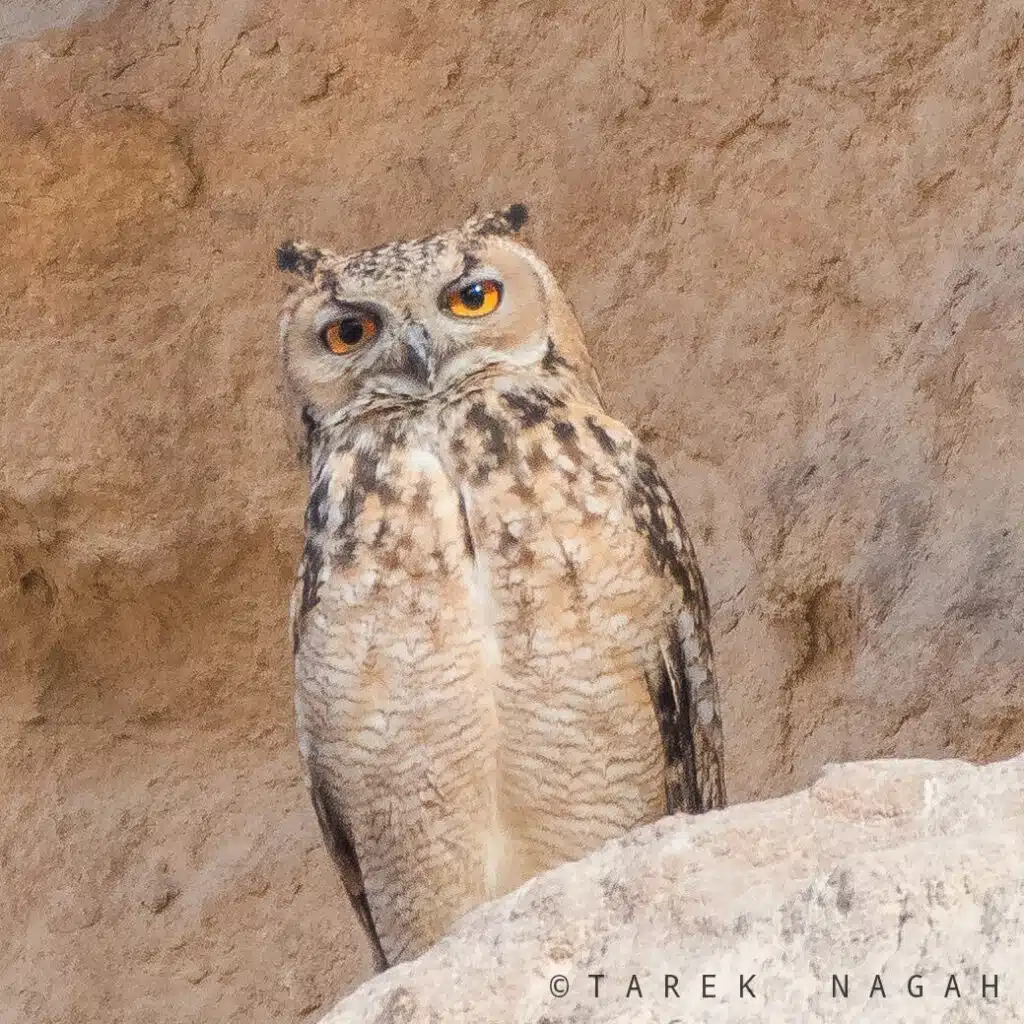
A long-living owl, The Pharoh Eagle-Owl (Bubo ascalaphus) is a species that lives in couples for life.
As Negros Scops-Owls, these owls are also monogamous and live in tree cavities, together for life.
They show orange-red and yellow eyes as well as a bright brown appearance.
Tan-brown plumage is specific to the dorsum while their round faces have a brighter nuance only contrasted by black margins.
Brighter areas are also seen on the ventral side of the species.
The range of these owls is extensive. Mostly found in North Africa, the owl is also present in The Middle East.
From Algeria to Israel, the species lives in warm climates.
Its typical foods include rodents, small, birds, eggs, and other vertebrates.
The red nuance of the eyes – orange-red, bright red
11. Puerto Rican Owl
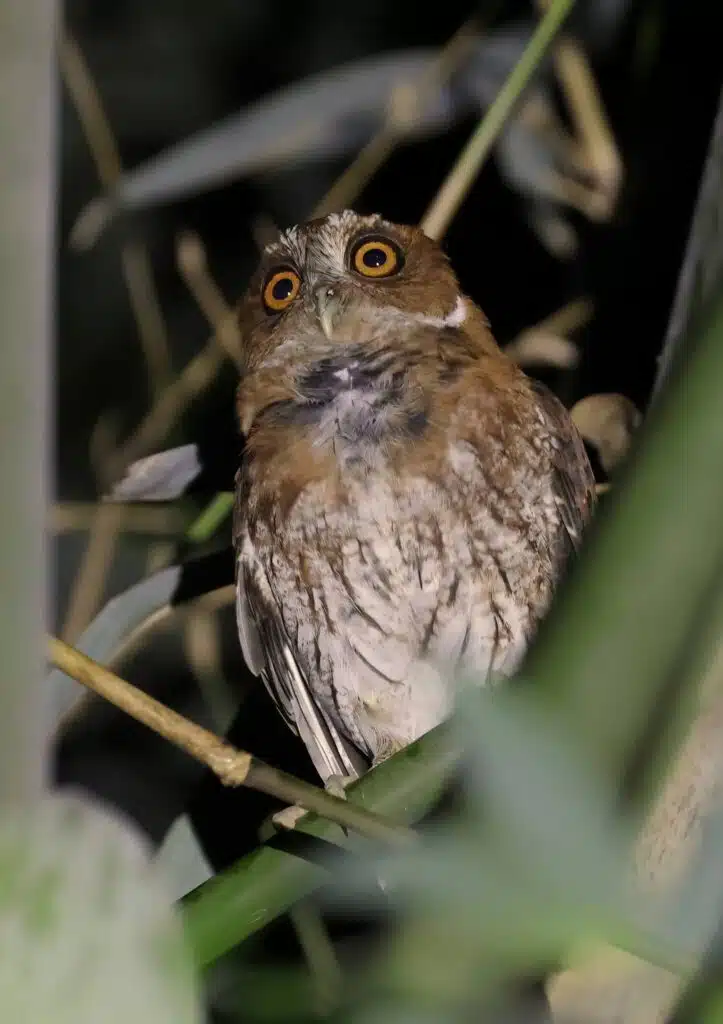
Puerto Rican Owls (Gymnasio nudipes) are also nocturnal but their eyes are still orange-red during the day.
They show dark red irises and pupils under artificial light at night.
Owls of this type are the sole species with a similar appearance in Puerto Rico.
Brown upper sides and white undersides are specific to these owls while owlets are mostly gray with brown eyes.
Some of the best times to spot groups of these owls is during the breeding season, at the beginning of the summer.
While nocturnal, the owls are highly active during the breeding season. This is when both males and females are heard with their loud vocalizations.
Owls of the species are mostly insectivores.
They feed on different types of bugs and insects only considering small lizards and birds when they’re quite large.
Puerto Rican Owls spend most of their days in tree cavities. They can also lay eggs here after breeding if they don’t lay them in the nests of other species
2-3 eggs are common within each nest.
The red nuance of the eyes – orange-red, dark red
12. Cape Eagle-Owl
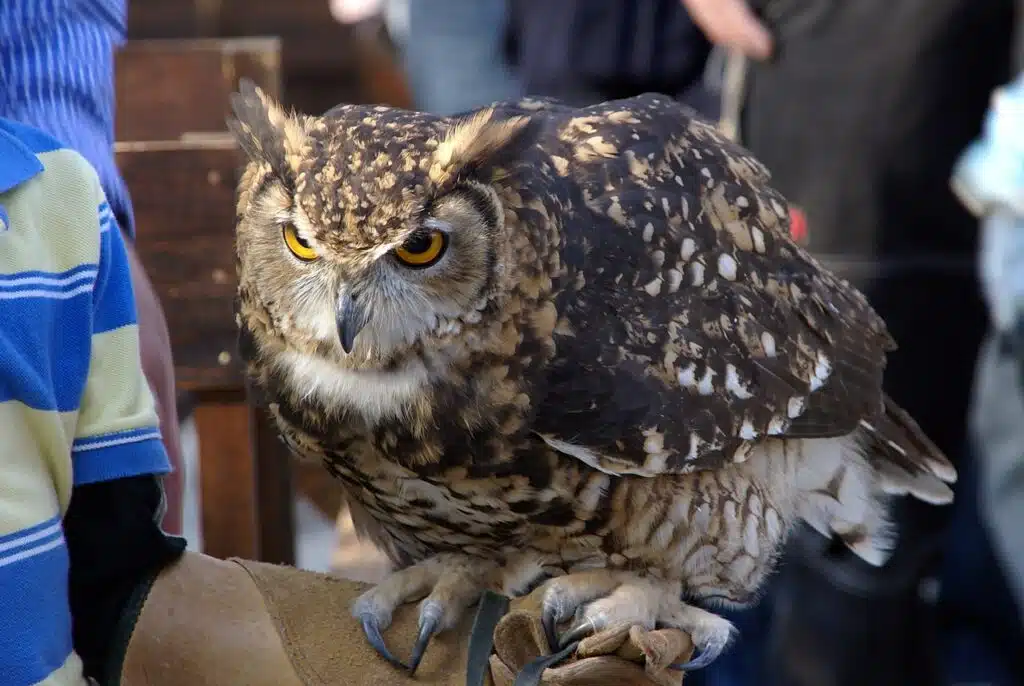
Cape Eagle-Owls (Bubo capensis) are some of the rarest types of owls with red eyes in Africa.
This is a species that lives in many countries such as Botswana and South Africa but its populations are fragmented.
Growing to a size of up to 24 inches, Cape Eagle-Owls are believed to be present in cities, parks, and vegetation around urban areas.
Even considered extinct in some of its traditional territories, this type of owl only comes out at night.
It features orange-red eyes and a dark brown appearance that dominates its plumage.
White plumage can vary depending on its subspecies. Yellow nuances may also be seen on the chest and around the head on some types of Cape Eagle-Owls.
Small mammals are its ideal foods. It eats rodents and shrews of all sizes.
The red nuance of the eyes – orange-red